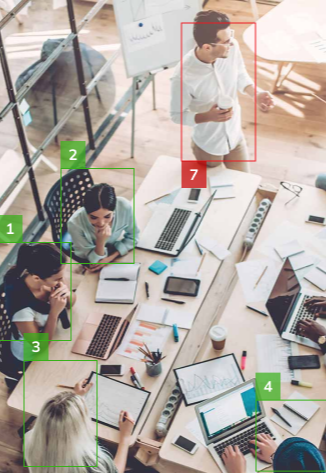Our People Counting solution counts and detects people in real-time through CCTV cameras, enhancing crowd management & security measures while increasing safety protocols. The real-time Dashboard reports monitor & analyze data, identifying potential security threats and optimizing operations.
People Count

Facilities often struggle to manage spaces effectively due to a lack of accurate data on foot traffic and occupancy. This can lead to overcrowding in some areas and underutilization of others, resulting in wasted resources.
Traditional methods of people counting, such as manual counting or turnstiles, are prone to inaccuracies and inefficiencies, particularly in high-traffic environments.
In industries like retail and event management, ensuring compliance with capacity limits is critical to maintaining safety regulations. Without real-time monitoring, it’s challenging to manage occupancy effectively.
Without reliable data on peak traffic periods, it’s difficult for businesses to optimize staffing levels, manage inventory, or adjust marketing strategies based on foot traffic patterns.

To solve these challenges, we implemented an AI-powered People Counting system that tracks the number of individuals entering and exiting facilities in real time.
Using high-definition CCTV cameras and AI algorithms, the system automatically counts individuals entering and exiting designated areas. It provides real-time data on current occupancy levels, ensuring accurate tracking of foot traffic.
The system generates automated alerts when occupancy levels approach or exceed capacity limits, allowing businesses to take immediate action to prevent overcrowding and maintain safety compliance.
In addition to real-time monitoring, the system offers comprehensive reports and analytics on foot traffic trends. Businesses can track peak hours, visitor patterns, and occupancy rates over time, enabling better planning and resource allocation.
The People Counting system can be integrated with other facility management tools, such as HVAC systems or lighting, to optimize energy consumption based on occupancy levels.
Busy environments, such as retail stores or event venues, may have fluctuating crowd sizes, making it difficult to count people accurately without AI based automation.
Handling large crowds during events or sales requires a high degree of accuracy to avoid miscounting or delayed updates.
In some cases, people may be partially blocked by objects or other individuals, which can affect the accuracy of traditional counting methods. AI must handle these occlusions effectively.
Facilities with multiple entry and exit points can pose a challenge in tracking the total number of individuals in real time, especially when people move between different areas within the space.
Low lighting conditions or glare from windows can impact the accuracy of video based counting systems, requiring AI algorithms to adapt to different environmental conditions.
Optimized space usage by 25% in the first quarter, repurposing underused areas and alleviating overcrowding.
Reduced operational costs by 15% through better allocation of staff and resources based on peak traffic patterns.
Reduced safety risks and non-compliance incidents by 30%, ensuring capacity limits were adhered to in real-time.
Informed marketing, staffing, and event planning with detailed foot traffic analytics, improving overall business strategy.
Lowered energy consumption by 10% by integrating occupancy data with HVAC and lighting systems for automated adjustments.
This website uses cookies to improve your experience. We'll assume you're ok with this, but you can back-out if you wish.